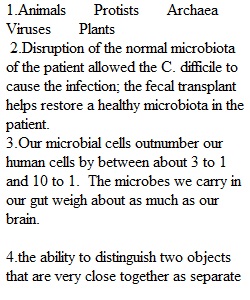


Q PartialQuestion 1 0.17 / 0.5 pts We are increasingly understanding how humans can be considered walking ecosystems, harboring an enormous diversity of non-human life! If you were to analyze all the microbes in and on your body, you would be able to find representatives of which of the following? Question 2 0.5 / 0.5 pts The bacterium Clostridium difficile causes nearly half a million infections annually in the United States, resulting in between about 15,000 and 30,000 deaths each year. This disease most commonly occurs in a healthcare setting, e.g., in hospitals and nursing homes, especially among immunocompromised and elderly, and in associationg with antibiotic treatment. A recent treatment being studied is a fecal transplant: namely, transferring a stool sample from the intestinal tract of a healthy donor to the patient. This process has yielded a very high success rate in clearing the C. difficile infection. What is the most likely explanation for this outcome? Question 3 0.5 / 0.5 pts Which of the following most accurately describes our current understanding of the human microbiome? Choose all that apply. Question 4 0.5 / 0.5 pts In microscopy, resolution is best defined as ______. IncorrectQuestion 5 0 / 0.5 pts The image shows a Gram stain of Bacillus subtilis, a common environmental species found in soils, magnified 1,000x. The clear small oval structures observed in some of the cells as well as outside them are called ______.
View Related Questions